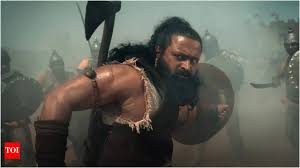Kantara Chapter 1: A Comprehensive Movie Review

Introduction
The Kannada film ‘Kantara Chapter 1’ has recently made waves in the Indian cinema landscape, garnering significant attention for its unique storytelling and cultural portrayal. Directed by Rishab Shetty, who also stars in the lead role, the film blends elements of folklore, action, and spirituality, making it a noteworthy addition to contemporary Indian cinema. Its exploration of themes such as tradition, land disputes, and the connection to nature resonates deeply with audiences, especially in the context of India’s rich cultural tapestry.
Plot Overview
Set in the lush backdrop of rural Karnataka, ‘Kantara Chapter 1’ revolves around the story of a young man named Shiva, played by Rishab Shetty, who finds himself embroiled in local conflicts over the land that holds great significance to his community. The narrative is deeply embedded in local folklore, particularly focusing on the ‘Bhoota Kola’ tradition, which adds a layer of authenticity to the film.
The film’s plot thickens as Shiva discovers the darker forces at play concerning the land dispute, and he must navigate the intricate relationships between tradition and modernity. The pacing of the film keeps viewers engaged, balancing intense action sequences with moments of deep reflection on heritage and belonging.
Character Performances
Rishab Shetty delivers a compelling performance, embodying the complexities of his character with finesse. His portrayal aligns closely with the film’s themes of loyalty and sacrifice, and his ability to convey emotion adds depth to the narrative. Supporting performances, particularly by Sapthami Gowda and Kishore, further amplify the film’s impact, bringing authenticity to their roles and helping to establish the film’s rural setting.
Cinematic Elements
The cinematography in ‘Kantara Chapter 1’ is striking, capturing the essence of the Karnataka countryside and complementing the film’s narrative beautifully. The use of traditional music and sound design enhances the viewing experience, grounding it firmly in cultural reality. The director’s attention to detail in showcasing local customs and practices contributes significantly to the film’s overall atmosphere.
Conclusion
In conclusion, ‘Kantara Chapter 1’ stands out as a remarkable film that combines entertainment with a profound commentary on cultural values and environmental issues. Its resonance with Indian audiences reflects a growing appreciation for narratives grounded in local folklore and tradition. As the film continues to be screened across theaters, it is becoming clear that Rishab Shetty’s project is not just a film, but a cultural phenomenon that encourages viewers to reflect on their roots. With its powerful storytelling, dynamic performances, and cultural significance, ‘Kantara Chapter 1’ is likely to pave the way for more such films in the future, bridging the gap between tradition and modern filmmaking.








